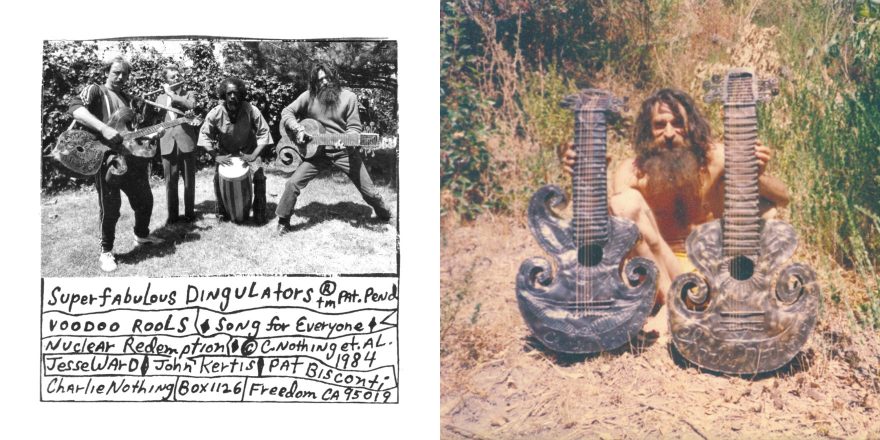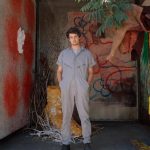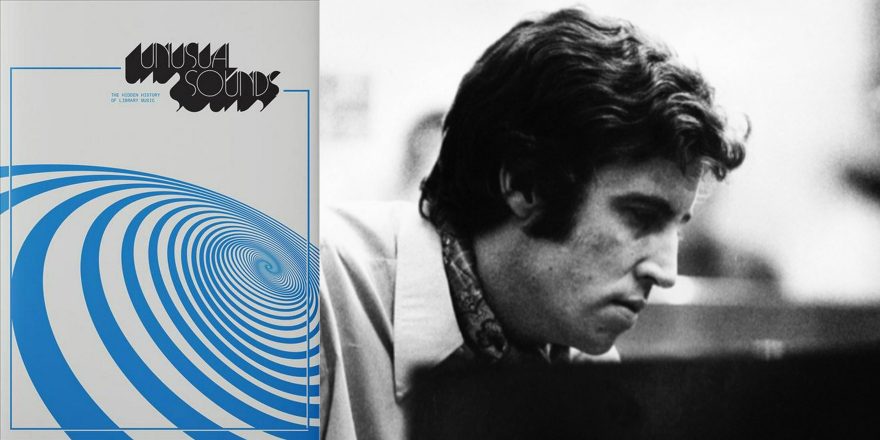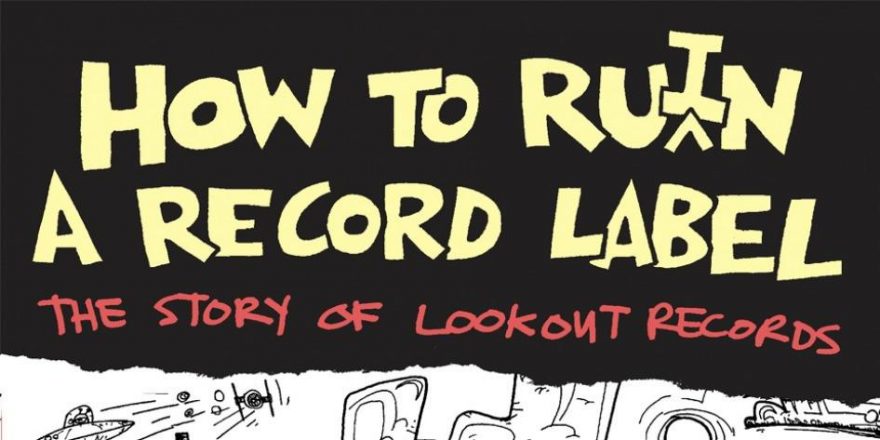Zully Adler’s upcoming book Charlie Nothing: State of the Ding (due out June 20, 2020) details his search for details about the life and instruments of Charlie Nothing, inventor of the dingulator, among other things.
Musician, writer, painter, horse breeder, beekeeper, and dealer of antique weaponry — Charlie Nothing was a little bit of everything. His ultimate undertaking was Charlie Nothing himself: an elaborate persona forged in concert with his “dingulators,” sculptural stringed instruments welded from American auto parts.
Too earthy for the beatniks, too vulgar for the hippies, and too sentimental for the punks, Charlie fashioned his own inscrutable brand of bohemianism across forty years in California, winding through circles of artists and outcasts, making friends as well as enemies, and ultimately forming his own renegade cosmos in and around Santa Cruz. The dingulators were a weapon in his war on conformity, at once an instrument for spiritual reflection and an armament for social sabotage. Their extreme atonality seems to mock the very notion of a musical philosophy, but, explored in the context of his other creations — chapbooks, artworks, novels, fliers, manifestos — they become a key to the mysterious cosmology of Nothing.
Charlie Nothing: State of the Ding assembles the relics of Charlie that I uncovered during a long search for the dingulators. In 2007, around the same time that Charles Martin Simon — also known as Charlie Nothing — died in Santa Cruz, I heard a record called The Psychedelic Saxophone of Charlie Nothing. The album had long achieved cult status for its two extended pieces of ecstatic improvised saxophone, eerie drones, and occasional hand drums. A number of intriguing rumors surround it: that Charlie had lived for decades on the beaches of California; that he could meditate in a handstand for a full day and night; that he performed in the bathroom of the Los Angeles County Museum of Art; that he was the father of modern apiculture; that he had dated Debbie Harry. I found his story as beguiling as his music.
Soon after, I read in an art gallery that the German artist Dieter Roth had enlisted someone named Charlie Nothing to install his 1970 exhibition, Staple Cheese (A Race), at the Eugenia Butler Gallery in Los Angeles. The show consisted of thirty-seven suitcases filled with large bricks of cheese that rotted over the summer, producing noxious fumes, attracting insects, and prompting calls to the police. It was an auspicious context to re-encounter Charlie.
Then, in 2010, I heard Dingulator Pat. Pending One, Charlie Nothing’s first dingulator album, reissued by Clint Simonson of the De Stijl label. The cover shows a gaunt figure holding a coiling, guitar-like instrument. The recordings barely resemble music. They were more a flurry of restless, metallic plucks. I didn’t like it. I didn’t dislike it either. I didn’t know what to think, which is why I loved it so much.
Cursory research yielded a few cryptic images. One showed a sad clown playing a rusty dingulator at a flea market. Another showed the interior of a music store with a dingulator hanging alongside acoustic guitars. The instrument looked like something that had shriveled up in the sun. A final image showed a cluster of dingulators in different shapes, sizes, and colors. I counted fourteen. Where were these things now?
Years later, without specific motivation, I wrote Clint Simonson from De Stijl and asked how I might find the dingulators. He wrote back suggesting I contact someone else: Kye Potter, an artist, record dealer, and collector of musical esoterica. Kye in turn provided the name and phone number of Casey Sonnaband, one of Charlie’s old friends from Santa Cruz. The following week I drove up from Los Angeles with Casey’s contact information in hand. What followed was a series of strange and illuminating encounters organized around my search for the dingulators.
◊
I met Casey at his apartment in Watsonville, twenty miles south of Santa Cruz. He was wiry and energetic for a man in his eighties, dancing around towers of books in his living room, pointing out pictures that covered the walls, and elaborating on their significance. His enormous salt-and-pepper eyebrows arched wildly, adding a certain drama to his stories. Casey explained how he and Charlie met as junk dealers at the Santa Cruz Flea Market. They shared an interest in music: Casey had played drums in the army and later congas for Anna Halprin’s Dance Workshop. A flirtation with the psychedelic movement led to a short gig as warm-up percussionist for Quicksilver Messenger Service. Like Charlie, Casey was a painter, and, also like Charlie, he despised the art world. His cousin Ileana Sonnabend had opened the prestigious Sonnabend Gallery in Paris in 1962. Casey condemned the relation. He remembered Charlie as someone similar to himself: a “son of a bitch” with a devious streak. As a junk dealer, Casey said, Charlie was always fair, but he enjoyed a vicious haggle and often riled up prospective buyers. This was just the way they passed the time.
Casey led me to a storage facility on the outskirts of Watsonville, where he kept most of his belongings. On opening the hatch, paintings spilled out onto the dirt — self-portraits in various shapes and sizes that exaggerated Casey’s strong nose and chin. They appeared deliberately unflattering. In the middle of the container was a full-size piano covered in knickknacks. Casey opened the lid and a cascade of objects fell to the floor. He pulled out a woven basket, rolled a joint from its contents, and smoked it while banging out a short improvisation on the black keys. Over the rest of the day we dug around for remnants of Charlie, finding several of his novels, tapes, chapbooks, and other ephemera — the first excavation to supply this book with material. Charlie’s creations shared a distinctive boilerplate: “rip me off, I break your face,” or the pithier “rip off, break face.” I admired his forthrightness. But I was looking for the dingulators themselves, and none could be found here. Casey thought he knew where one might be.
The next day we drove to the home of Charlie Tweddle, an eccentric country musician and milliner of high-end cowboy hats. Casey insisted he find Tweddle’s house by memory, which wasn’t too difficult: a Honda in the driveway bore the license plate TWEDDLE. When we knocked on the door Tweddle emerged wearing a trucker hat with a pig’s snout sewn onto the front. He beamed a pink smile from under his white beard and thick glasses, and as we shook hands I was surprised to feel him tickle my palm with his index finger. Tweddle showed us into the living room, full of hats festooned with colorful feathers, reptile scales, and animal eyes. The raw materials, he explained, came from local road kill — a matter of ethics as well as finances. I found this as fascinating as I did unsettling. But there was a quiet, compelling elegance to Tweddle’s designs, and I wasn’t the first to fall under their spell. His website boasts sales to Cher, Reggie Jackson, Kate Hudson, Rob Schneider, and every member of the Eagles.
Tweddle took us through the house to the backyard, where he gestured to a large chicken coop. Slung up under cobwebs was one of Charlie’s biggest dingulators. The fingerboard was eight inches wide, with raised wire frets that curved unevenly and strings that now dangled in every direction. Two-pronged horns protruded from both sides and thick layers of rust peeled at its edges, giving the instrument a distinctly wicked appearance. Tweddle was surprised by my interest, and asked what this instrument meant to me. I told him that I didn’t quite know, but that I hoped to find out. For now, at least, I could be certain that one dingulator still existed.
Later that evening, at a motel in Salinas, I pored over the other discoveries from Casey’s storage, pausing at a poster with the word DINGALETTER™ printed across the top. It showed Charlie standing with three other men under the name Superfabulous Dingulators, followed by an explanatory text:
I make my ‘guitars’ out of American cars.
Dingulator ™® pat. pend. is what I calls dem.
Dingulator ™® pat. pend. is what dey are.
So sings Charlie Nothing in his song, AIN’T NO FASCIST GONNA TUNE DESE STRINGS
and so he does, he and Patrick Bisconti, the sole inventors/creators and hand makers of these authentic historic instruments, sculpted with 100% steel recycled from American automobiles.
As if that weren’t enough, with the artistry of John Kertis, maker/player of the bamboo flutes and rapper extraordinaire, and the mastery of Jesse Ward Jr. on congas, etc., they have evolved a TOTALLY NEW TYPE OF ARTMUSIC/CONSCIOUSNESS. These four comprise the nuclear personnel of the SUPERFABULOUS TEAM DINGULATER ™® pat. pend., conspiring to demonstrate IT in unusual performances, concerts, and environmental gigs.
So there was a whole dingulator band. Where were these guys now? It would take months to track down John Kertis in Ojai, and to learn that Jesse Ward Jr. had died not long ago. But from my motel room in Salinas it took only a few moments to find the personal website for the man named Pat Bisconti. On the homepage was a drawing of a rat dressed in overalls and holding a painting of the third eye. The sidebar included a page called Musical Instruments with two pictures of a man playing a massive metal instrument in a shape that can only be described as an evil butterfly. This was definitely the right Pat Bisconti. I sent a message through the website’s contact portal and included my phone number. The next morning I received a call from a soft-spoken older man, who, after considerable back and forth, said that he was Pat. He shared his address and by noon I was at the Bisconti residence in Aptos.
Pat has a gentle, round face with wise wrinkles and keeps his remaining grey hair pulled into a ponytail. His wife Nancy—small, affable, and generous with her words — did much of the talking. Their hallway was lined with Pat’s shakuhachi flutes and smooth ambient music wafted quietly from the TV speakers. They invited me to sit with them in the living room and their stories unfolded.
Pat and Nancy met Charlie in the latter half of the 1960s, when they lived in neighboring cabins on Twin Lakes Beach. At the time, they explained, Charlie was paranoid and beside himself. He had moved abruptly from the East Coast one or two years earlier, after the death of his first wife Beth Ann. Charlie and Beth Ann had grown up in the Jewish community of Newark, New Jersey, where his father, a Holocaust refugee, was the town dentist. By their late teens, the young couple had joined the free love movement and moved to New York, where they fell under the guidance of a macrobiotic guru named George Ohsawa. Beth Ann was fanatical about their new health regime, and committed herself to diminishing portions of rice and tea. She became increasingly sick and frail, but refused Charlie’s attempts to reintroduce other foods into their diet. When she died from complications due to malnutrition (years later Charlie would speculate that cancer was the cause), many blamed Charlie. News outlets reported the death as part of a cult ritual. Charlie soon left the East Coast for good and, in his own words, “went as far west as I could get without getting wet.” He landed first in Los Angeles, stumbled up the coast to the Bay Area, where he recorded The Psychedelic Saxophone of Charlie Nothing, and eventually settled in Santa Cruz. Pat recalled that Charlie remained obsessed with nutrition, and continued to experiment with the alimentary benefits of insects, grass, and air. But Charlie also returned to more standard fare, and even hosted an art exhibition in his favorite ice cream shop.
Charlie quickly noticed Pat Bisconti’s musical inclinations. Leaving the East Coast, Charlie had disbanded the First Uniphrenic Church and Bank Band — a group claiming double tax exemption as both religious organization and credit union — and he was now looking for new collaborators. It was Pat, in fact, who paved the way for the dingulator. He had been welding his own instruments since the early 1960s with the guidance of a Bay Area artist named Ron Boise. Boise was famous for a welded instrument called the Thunder Machine, as well as a series of metal Kama Sutra sculptures installed on the beaches of San Francisco, seized by the police for pornographic content, and subject to a widely publicized freedom-of-expression trial. When he died of exposure to copper fumes, Pat inherited his welding tools and began to make metal kalimbas and horns. He shared these tools with Charlie, and together they experimented with different guitar shapes until Charlie arrived at the curling tentacles of the dingulators. Pat and Charlie both played their instruments as aggressively as possible. It therefore made sense to use the heavy steel they could salvage from dead cars. Charlie preferred Chevrolet and Ford, but as far was Pat was concerned any steel worked, as long as it resonated well and “could take a beating.”
Their favorite venue was Club Zayante in Felton, a small town in the mountains north of Santa Cruz. Pat and Charlie played there every Sunday with a group of what Pat called “mountain people” — hippies and country folk who descended on the bar to barbeque and swim in the backyard pool. They refused to play on the house stage or use the bar’s speakers, setting up instead around a picnic table in the courtyard. Their sets lasted hours, with others joining on hand drums and flutes. Sometimes Charlie would get up in the middle of a song and return with more players and instruments. Other times Pat and Charlie would leave Club Zayante and let the music continue without them. Much of the time, however, Pat and Charlie would pound out their own two-man cacophony. “We usually cracked the sound barrier pretty early on,” remembered Pat, “and eventually it would just fall apart.” Whether or not the dingulators earned them fans, Pat couldn’t say. But he knew the owners of Club Zayante liked having them. “Sippers became gulpers,” he recalled. People loved or hated the music, but in any case, they bought more drinks.
Charlie retrofitted a van for the dingulator band, stripping the paint, letting the body rust, and varnishing the grey-brown exterior. When the transmission failed, he cut a large hole out of the car’s bottom, welded poles directly to the gears, and operated them by hand. Travelling to and from concerts, they watched the road pass underneath them.
Pat motioned me upstairs to his study, where he had assembled various Charlie-related materials: a lyric book in Charlie’s distinctive cursive, a poster from his pre-dingulator band the Sons of Eternity, a box of Ain’t No Fascist singles by the Superfabulous Dingulators, and a letter from Ronald Reagan thanking the band for a promotional copy of the record. There was also Charlie’s bamboo flute — the largest I had ever seen. The holes were so far apart it was impossible to stretch my fingers over them. Pat explained that Charlie’s commitment to yoga had made his body implausibly elastic. He could extend his fingers disproportionately and exhale remarkable quantities of air. It was clear that Charlie enjoyed playing instruments that other people simply couldn’t.
Pat described the dingulators as devices for meditation. “You didn’t make music on them,” he said, “you made music with them.” He used the analogy of the Fuke-Sect monks, who roamed the countryside playing bamboo flutes. Some wore woven baskets over their heads to increase the sound’s resonance and induce inward focus. Playing the dingulators was similar: Charlie and Pat would run their fingers over and over the strings, seeking transcendence in the pulsing ring of overtones. This, I came to understand, was the state of the ding — a hovering prana reached through extended dingulation. But the Superfabulous Dingulators also had a social agenda. Their anti-music was a weapon against consumerist homogeny. That Pat and Charlie’s songs never cohered around rhythm or melody was important. Dingulation had to exceed all accepted notions of creative expression. “If you were going to be an artist,” Charlie later wrote, “you had to be saying something. There was another school, that was into saying nothing, with fewer proponents and a rare atmosphere, where Art and Reality always were, are, and will be One.”
In order to raise money for publication, Zully is offering original dead-stock copies of the Charlie Nothing Dingulator Band’s Ain’t No Fascist 7” record, which you can buy here.







